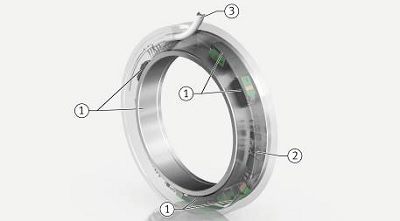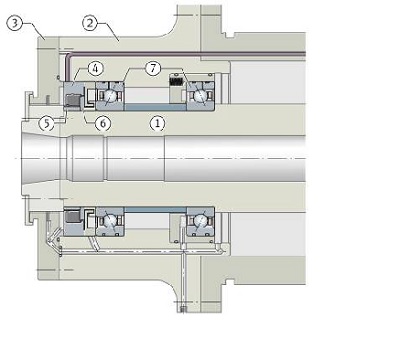
Design of the Schaeffler SpindleSense monitoring system: 1 Distance sensors; 2 Evaluation unit; 3 Connection cable
The main spindle is crucial to the performance capability of the complete machine tool. It is at the heart of the machine and largely defines the achievable cutting capacity, surface quality, and precision. In turn, the spindle bearing support is one of the most heavily loaded components because it must transmit machining forces precisely at very high speeds for long periods of time and the risk of collisions can never be ruled out. It therefore comes as no surprise that the majority of machine tool downtimes can be traced back to defective spindles, particularly as a result of collisions and continuous, undetected overloads. In milling operation, for example, the combination of high radial loads, long tool protrusions, and high speeds leads to particularly high loads and unfavorable kinematic conditions on the spindle bearing in the vicinity of the tool. These unfavorable and in some cases impermissible loads occur because operators have hitherto not had a suitable tool, with which they could monitor borderline loads on spindle bearings. Schaeffler has now solved this problem with its new SpindleSense monitoring system.
Ready for volume production to coincide with EMO 2019
The first production-ready SRS sensor ring units including radial and axial measuring ring with an inside diameter of 70 mm will be available for customers to test in practical applications to coincide with EMO 2019. Additional sizes with 80 and 100 mm inside diameter will be available at the end of the year. All units have a standard width of 16 mm. The scope of delivery includes an SST setup service tool, with which SpindleSense can be parameterized and put into operation.
- Detecting a crash (collision): The sensor technology is capable of signaling an overload at a digital output within 2 milliseconds. This allows serious subsequent damage to be minimized or even prevented through fast deactivation of the drive.
- Long-term protection for machine tool spindles: In practice, continuous mechanical spindle bearing overloads are not immediately identified. In contrast, SpindleSense immediately triggers a warning signal when the overload is parameterized accordingly. The operator can adjust his machining program right after the first manufactured part and reduce the spindle load by using a new tool or modified cutting values, or by employing a more suitable tool type. The operator thus achieves lower and less numerous peak loads, and thus benefits from a longer spindle operating life with fewer machine tool downtimes, which ultimately means more production time and reduced repair costs.
Two options are available for outputting the measured values. Variant C-A0 transmits alarm signals as soon as the individually defined limit values for the bearing load and kinematics are reached. Variant C-A1 outputs the measured radial and axial displacements including tilting via CAN bus. Machine tool and spindle manufacturers can use these displacement values to develop analysis tools for optimizing the utilization of spindle capacity, e.g. by visualizing the deflection collective measured by the sensor ring as a load collective. For the first time ever, the machine operator will know the degree to which the spindle capacity in each machining process is being utilized as a percentage with a high level of accuracy and thus be able to adjust the machining process even more precisely in terms of capacity utilization and operating life for each machine: This means that harmful overloads are prevented despite maximum spindle loads. Safe operation in the limit range allows the operator to increase his or her productivity and also to benefit from longer spindle operating life and less frequent machine downtimes.















